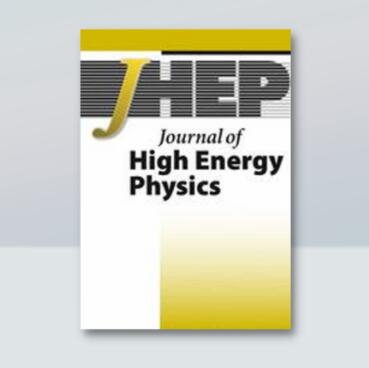交叉/磁化d膜模型中不可逆风味对称性的量子方面
IF 5.4
1区 物理与天体物理
Q1 Physics and Astronomy
引用次数: 0
摘要
讨论了环面轨道上IIA型交叉和IIB型磁化d膜模型中手性物质的选择规律。由于环面轨道上的手性物质是由测量轨道群的某一共轭类来标记的,因此选择规则涉及非平凡的融合规则。我们发现手性物质的表示是用树级磁通或圈数偶数的D4风味对称来描述的。此外,即使我们考虑到循环效应,D4对称性仍然存在。我们还研究了非微扰效应,如d膜瞬子。本文章由计算机程序翻译,如有差异,请以英文原文为准。
Quantum aspects of non-invertible flavor symmetries in intersecting/magnetized D-brane models
We discuss selection rules of chiral matters in type IIA intersecting and IIB magnetized D-brane models on toroidal orbifolds. Since the chiral matters on toroidal orbifolds are labeled by a certain conjugacy class of the gauged orbifold group, the selection rules involve non-trivial fusion rules. We find that the representation of the chiral matters is described by a D4 flavor symmetry for an even number of magnetic fluxes or winding numbers at tree level. Furthermore, the D4 symmetry still remains even when we take into account loop effects. We also study non-perturbative effects such as D-brane instantons.
求助全文
通过发布文献求助,成功后即可免费获取论文全文。
去求助
来源期刊

Journal of High Energy Physics
物理-物理:粒子与场物理
CiteScore
10.30
自引率
46.30%
发文量
2107
审稿时长
1.5 months
期刊介绍:
The aim of the Journal of High Energy Physics (JHEP) is to ensure fast and efficient online publication tools to the scientific community, while keeping that community in charge of every aspect of the peer-review and publication process in order to ensure the highest quality standards in the journal.
Consequently, the Advisory and Editorial Boards, composed of distinguished, active scientists in the field, jointly establish with the Scientific Director the journal''s scientific policy and ensure the scientific quality of accepted articles.
JHEP presently encompasses the following areas of theoretical and experimental physics:
Collider Physics
Underground and Large Array Physics
Quantum Field Theory
Gauge Field Theories
Symmetries
String and Brane Theory
General Relativity and Gravitation
Supersymmetry
Mathematical Methods of Physics
Mostly Solvable Models
Astroparticles
Statistical Field Theories
Mostly Weak Interactions
Mostly Strong Interactions
Quantum Field Theory (phenomenology)
Strings and Branes
Phenomenological Aspects of Supersymmetry
Mostly Strong Interactions (phenomenology).
 求助内容:
求助内容: 应助结果提醒方式:
应助结果提醒方式:


